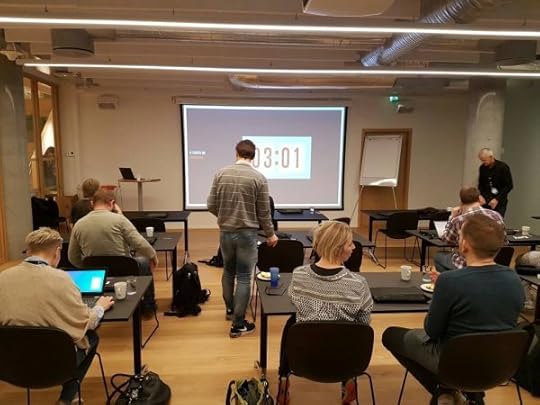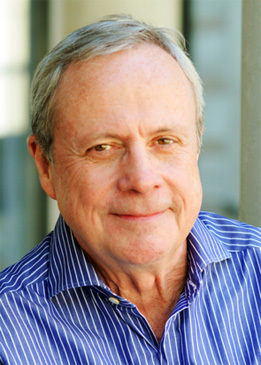David Allen's Blog, page 42
March 27, 2018
Episode #39: GTD® and Holacracy®
In this podcast we hear a wide-ranging conversation between David Allen and the founder of HolacracyOne, Brian Robertson. Just as GTD is a systematic approach to maintaining perspective and control in your life, Holacracy is a systematic approach for running an organization. You’ll hear a lot of interesting similarities between the two models, as well as their shared history and purpose.
Listen Now
Subscribe or Download
iTunes
Stitcher
Libsyn
Google Play Music
Spotify
SoundCloud
The post Episode #39: GTD® and Holacracy® appeared first on Getting Things Done®.
March 20, 2018
GTD Stories: Enyo
 Your name:
Your name:
Betty Enyonam Kumahor, but most people just call me Enyo.
What do you do for work?
I find this question harder and harder to answer! My background is in management and technology consulting. I started my own consulting firm about 2 years ago and we have about 25 people in 3 countries doing mostly technology consulting but a fair bit of management and design-thinking consulting as well. I also spend a fair amount of time speaking and in governance as I hold a number of board and advisory positions.
Where do you live?
My home countries are the United States (Atlanta) and Ghana (Accra) though work puts me in Ghana fairly often.
How did you hear about GTD?
It was fairly early in my career and I was literally failing at my job at the time. Seriously! I thought I was going to get fired. I was on a business trip walking through I believe Dulles airport and stopped in a bookstore. I noticed the title Getting Things Done and thought “that is definitely what I need!” So I didn’t “hear” about GTD so much as saw a book surrounded by sparkling lights and I hopped and skipped towards it!
How long have you been practicing GTD?
I saw the book in 2002 maybe and started reading it right after that. I attempted my first full implementation about 5-6 months later. It’s a good thing you say practicing because I had to repeat that for about 4 more years! So I have been practicing GTD for 15 years at least.
How has GTD made a difference in your work and life?
It’s completely transformed it! How do I count the ways?
It has certainly made me more efficient. I was able to get an incredible amount of work done in less time and that helped me both professionally and personally.
When that happened I realized I wasn’t focused on the right things in my life and I wanted to change the balance. GTD helps me make that pivot fairly easily by just starting with my higher horizons view and trickling that new view into a different set of projects and actions.
GTD has also helped me significantly reduce my guilt. Guilt over what I didn’t do, who I didn’t help, what I said no to, or didn’t say no too. It helped me get a handle on my commitments and gave me the justification (aka excuses) to say yes to only the projects and actions that most aligned with my higher horizons.
I credit GTD as being the stepping stone for all my professional achievements and some of my personal ones.
What areas of GTD are you doing really well (or at least better than you used to)?
Renegotiating my commitments has been the most challenging aspect for me to get down in recent years. I simply hate saying no, and this was compounded because many of my professional achievements came because I was the one who would say yes and work the difficult problem as long as it took to get solved. It took a while for me to first get the Three-fold Nature of Work, then real prioritization across all horizons of focus, and then renegotiating my commitments.
What areas of GTD would you like to get even better at doing?
In terms of practice, I am quite solid at the moment. Of course every time I have said that I then realize there is some aspect that can indeed be improved and that ‘Oh, GTD has an answer for that too!” But for now, I would be chuffed to have a simplified cohesive coordinated set of tools for my GTD ecosystem so I can reduce the administration that happens with having as many tools as we sometimes need.
What is one piece of advice you would give to someone just starting out with GTD?
Keep at it! GTD is large toolkit of practices, techniques and habits and it can get difficult at times when you’re just starting. Nowadays there is such great information on GTD Connect, Productive Living and all the GTD training. Don’t hesitate to leverage on all that fantastic experience of others who have made the journey. GTD Connect is such a generous community so do get and try the advice. Make time in your schedule to learn GTD. Some of it will pay off immediately, but some later. But most importantly, keep at it—it’s SO worth it.
The post GTD Stories: Enyo appeared first on Getting Things Done®.
March 2, 2018
Priorities and GTD
A GTD Connect member asked:
I have at least 100 projects, from LARGE to little. Now you break that down those projects to single actions which at least triples your actions. So I might have about 300 single actions to be done.
Wouldn’t the first thing to do be according to priority? The LARGEST and Loudest? The one that is going to give you the largest return, like not get fired on the job?
I’m still working on perspective, cause I know that has a lot to do with it. but just wanted a little help on the day to day, minute by minute tactical level.
GTD Coach Kelly Forrister responded:
1/ Context is first since it will always be required to do what you want to do. For example, if your computer is required to write an email, but you don’t have it with you, then you can’t take that action. If being @Home is required to mow your lawn, but you’re not home, you can’t take that action.
2/ Time available is also a limitation in that if you don’t have the time to take an action, it won’t matter if it’s high priority or not. If you only have 10 minutes, but you need an hour to take an action, that will eliminate some choices.
3/ Resources will make a difference in terms of what you have the energy and resources to do. If you are brain toast, good chance you won’t want to do that high priority thing anyway, since you won’t have the mental horsepower for it. Ever have that feeling that your brain works better/worse at different times of the day? That’s resources. You will naturally make different choices.
4/ When the first 3 limitations have narrowed down your choices, then it’s time for strategic thinking: priority. What will give you the biggest payoff to do in this moment? Maybe in one moment that’s won’t get you fired and another what will make you the most money. And the next day it might be what will make your boss happy and the next what will make your spouse or partner happy. Two questions that can help clarify what to choose are:
What’s the value in getting this done?
What’s the risk if I don’t?
If you aren’t crystal clear on your priorities, I would climb up the Horizons of Focus, especially to Areas of Focus to know what you are actually responsible for personally and professionally. Many times people will do that and realize they have things on their projects + actions that are not really their job. If you are not sure what your areas are (most people have 5-7 personally and 5-7 professionally) then maybe it’s time for some updates on that with people you think can help you get clear on that.
And, don’t under estimate what full capture, clarify and organize will do. Only when those are really complete will you fully trust your intuitive choices about what to do. Otherwise, you’ll have that nagging sense you’re missing something that might be more important.
The post Priorities and GTD appeared first on Getting Things Done®.
March 1, 2018
Where to find GTD training
GTD public courses and coaching services are offered in more countries than ever before, through our extensive network of Global Partners. Here’s the dashboard to find GTD training near you: https://gettingthingsdone.com/global-partners

The post Where to find GTD training appeared first on Getting Things Done®.
February 27, 2018
Behind the scenes with David Allen
David Allen welcomed Blinkist into his apartment in Amsterdam for a casual conversation about GTD, writing the book, and his love for clear space.
The post Behind the scenes with David Allen appeared first on Getting Things Done®.
February 22, 2018
Why I do GTD
In response to last month’s David Allen article, Turning Inside Out, GTD fan and musician Don Richmond shared:
This underlying philosophy, or reason for the existence of GTD, is what turned me on to it in the first place. I don’t really need to do more things—I do too much already. But I do need to be able to do what I do without it grinding me to hamburger, so I can have space to be, to breathe, to live, to write songs, to experience the wonder of being alive. And GTD is helping me to work toward that—slowly, slowly! Lots of room for improvement, but I’m getting there. Thank you all for your work! –Don

The post Why I do GTD appeared first on Getting Things Done®.
February 21, 2018
Are You Capturing Your Good Ideas?
How many thoughts and ideas do you have daily which represent useful things to do or potentially enhance or improve projects, situations, and life in general? How many have you had and forgotten, and forgotten that you’ve forgotten?
situations, and life in general? How many have you had and forgotten, and forgotten that you’ve forgotten?
“I ought to call Susan and ask her about where she stayed in Hawaii…”
“I need to write up the meeting agenda and email it to the team.”
“Wonder what marinade I’d use to cook a lamb on the grill…”
“I ought to update Bill about my conversation with his customer
Etc.
Most people have (or could have) many more of these kinds of thoughts than they realize, during the course of any 24-hour period. Most people don’t get value from many of them, because they lack both the habit and the tools to collect those thoughts when they occur. If they aren’t captured, they are useless, and even worse can add to the gnawing sense of anxiety most people feel about things “out there” they know they’ve told themselves they should or would like to do, but don’t remember consciously what they are.
I’ve had thousands of ideas and fun or important to-do’s actually come to pass, and kept a refreshingly empty head about all of them, because I’ve managed to create the habit of grabbing those thoughts when they occur. Many people view improving personal organization skills and tools as a “fix” or at best a “maintenance” need. Yet from my experience gaining the habit of capturing and organizing all of my thinking can take on a much more creative and proactive spin.
Two things are needed to implement this standard and make it easy: (1) a collection tool with you at all times, and (2) the habit of processing all the thoughts within a short period of time (ideally, every 24–48 hours).
(1) Simple, small tools are required. They can be analog, digital, or both. I’ve used a note-taker wallet for years for this purpose because it has critical plastic cards and is with me ubiquitously. I also capture into my portable digital tools by grabbing thoughts I forward as new emails for me to process.
(2) You must process these thoughts into your organization system soon, and completely. If you leave emails unprocessed in your inbox, or paper notes piled up in a briefcase or notepad somewhere, the whole process is defeated, and your motivation to continue will disappear.
But if you do get the tools, use them when you think, and organize the results into your system, I guarantee you’ll have more thoughts. And good ones, too.
The best way to have a good idea is to have lots of ideas.
—Linus Pauling
Did you ever stop to think, and forget to start again?
—A.A. Milne
–David Allen
This essay appeared in David Allen’s Productive Living Newsletter. Subscribe for free here.
The post Are You Capturing Your Good Ideas? appeared first on Getting Things Done®.
February 15, 2018
GTD and Information Overload
People complain about “information overload.” But, in truth, the most information-rich environment is the most relaxing–nature. We are actually more relaxed and stimulated by a plethora of input and multiple horizons, and nature provides that in spades. If you really wanted to go nuts, just put yourself in a room with no input (sensory deprivation.) The pressure of “too much information” is actually created by inputs that require thinking and decision-making (email, texts, meeting notes, commitments not engaged with appropriately, etc.)
Nature is a bounty of cool things to notice, stimulating sights and sounds, but which require almost nothing of our minds.
–David Allen

The post GTD and Information Overload appeared first on Getting Things Done®.
February 9, 2018
EPISODE #38 – The Power of Outcome Thinking
David Allen explores the power of outcome thinking in front of a live audience. This talk will reveal just how much the thoughts we hold in our head have the potential to affect the types and qualities of action we take. From athletic performance to prepping for that next big meeting, what we think about while we act can affect how we act.
Listen Now
Subscribe or Download
iTunes
Stitcher
Libsyn
Google Play Music
Spotify
SoundCloud
The post EPISODE #38 – The Power of Outcome Thinking appeared first on Getting Things Done®.
February 1, 2018
What is GTD®?
 Someone recently asked David Allen to share the underlying principle to Getting Things Done® (GTD®). He said:
Someone recently asked David Allen to share the underlying principle to Getting Things Done® (GTD®). He said:
There are several, but the main ones are:
1. CLEAR YOUR HEAD – Your head is for having ideas, not for holding them. In other words, build and maintain an “external brain” to hold all your significant reminders of commitments and creative thinking. You need mental and emotional space to be present in the moment, to be optimally creative, strategic, innovative, and ready for change and surprise.
2. THINK AND DECIDE – Whatever has your attention needs specific thinking and decision-making in order to put it onto “cruise control” and to be appropriately engaged with it.
3. KEEP A TRUSTED SYSTEM – You need a trusted system to maintain a current inventory of your commitments and intentions, reflected upon regularly.
—
Which of these has made the biggest difference for you? Where are your opportunities for improvement?
The post What is GTD®? appeared first on Getting Things Done®.
David Allen's Blog
- David Allen's profile
- 1485 followers



